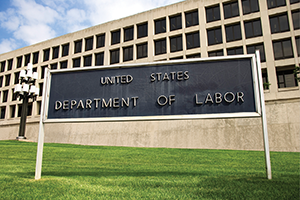We’ve long expected aggressive action from the Biden Administration in the labor space, and during the past couple of months we’ve started to see it. Some of the action out of the U.S. Department of Labor (DOL) likely has been delayed by the failure to get former Obama Labor Department Wage and Hour Division Director Dr. David Weil confirmed to the same position. Weil’s nomination was rebuffed by moderate Democrat senators, who rejected a procedural motion to bring the nomination to a floor vote for confirmation back in March. In early August, President Biden nominated the division’s acting director, Jessica Looman, to be the confirmed director, and her nomination is still pending Senate action as of this writing in mid-October. Looman, though, has not been sitting on her hands as acting director as she has overseen the department’s rescinding of a handful of Trump-era rules, including the joint-employer standard and independent contractor analysis.
We’ll get back to the DOL in a moment, but the first major rulemaking proposal in the labor arena was issued by the National Labor Relations Board (NLRB). In early September, the NLRB issued a notice of proposed rulemaking outlining its intent to loosen the rules governing analysis of joint-employer relationships. The guidelines and rules surrounding what constitutes a joint-employer relationship have been volleyed back and forth by successive administrations since 2015. That year, the Labor Board decided in Browning-Ferris that one company need only have the contractual right to control an employee’s working conditions to be deemed a joint employer. The Trump Administration reversed those guidelines and took the extra step of issuing a formal rule tightening up the guidelines and laying out that one employer would have to actually enforce such a right to be deemed a joint employer. That rule was remanded back to the Labor Board by the D.C. Circuit Court of Appeals at the end of July.
 JOINT-EMPLOYER RULE
JOINT-EMPLOYER RULE
So, while the Browning-Ferris case remains alive at the NLRB, the board has issued the notice of proposed rulemaking to attempt to formalize not only a return to the Obama-era interpretation but also a significant expansion of it. Under the current proposal, the existence of a contractual right to determine even one essential term or condition of another companies’ employee, regardless of whether such right is executed, can determine a joint-employer status. The proposal goes further by leaving the list of what terms and conditions are “essential” open-ended and attempting to satisfy a 2018 federal court decision by saying that any such right is automatically substantive to that employee no matter what it is. Such a rule would dramatically expand the universe of who could be deemed a joint employer of another companies’ workers, potentially subjecting them to sanctions for violations of labor law and or required collective bargaining. NACS has filed comments with the NLRB opposing this new proposal, but as of this writing, the board has not released a final rule including implementation deadlines.
INDEPENDENT CONTRACTORS
Turning our attention back to the DOL, as we said, Acting Administrator Looman already rescinded a few different Trump-era rules and recently started the process of formally rewriting them. First on her agenda is the independent contractor rule. The rule is used to determine if a worker should be properly classified as an independent contractor or an employee. The Trump Administration had put the onus on two factors, control over the work and opportunity for profit or loss in making such a determination. The current DOL has proposed a larger “totality-of-the-circumstances” analysis, which doesn’t put greater weight on any individual factors. The loosening of that rule will make it much easier for people currently classified as independent contractors to be reclassified as regular employees and thus covered by more-stringent labor laws and eligible for some benefits. While the focus of the change is on so-called gig workers, like delivery and rideshare drivers, the impact would likely be felt in wider segments of the economy.
The guidelines and rules surrounding what constitutes a joint-employer relationship have been volleyed back and forth by successive administrations since 2015.”
WHITE-COLLAR WORKERS
Looman also has indicated that the DOL will seek to make changes to the overtime rule’s “white-collar exemption,” which was just formally changed in 2020. Recall that the Obama Administration under former WHD Director Weil attempted to sharply increase the salary threshold that established the minimum salary for exempting employees from overtime pay under the white-collar exemption to over $900 per week from its then-current level of $455 per week. That action was ultimately nullified by a federal judge.
In 2019, the Trump DOL issued its own rule, setting the salary at $684 per week, a level that essentially adjusted the old number for inflation. Now, the Biden DOL has indicated that it intends to once again look at that rule and those thresholds. The department likely will seek to increase the salary thresholds and also may look to adjust the “duties tests” meant to evaluate an employee’s actual job responsibilities in determining eligibility for exemption.
The Labor Department had indicated that the overtime proposal could be issued as early as October 2022, but as of this writing, no such proposal is out. In April 2022, NACS government relations staff and former NACS Chair Rahim Budhwani participated in a DOL listening session to make the case for leaving the current rule in place.
Those are just the big-ticket items that the Biden Administration labor agencies have either started work on or have announced intentions to address. There may be more labor-friendly regulation coming down the pike soon enough. NACS will work to keep you informed of any future developments or proposals.